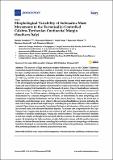Por favor, use este identificador para citar o enlazar a este item:
http://hdl.handle.net/10261/197789COMPARTIR / EXPORTAR:
 SHARE SHARE
 CORE
BASE CORE
BASE
|
|
| Visualizar otros formatos: MARC | Dublin Core | RDF | ORE | MODS | METS | DIDL | DATACITE | |

| Título: | Morphological Variability of Submarine Mass Movements in the Tectonically-Controlled Calabro-Tyrrhenian Continental Margin (Southern Italy) |
Autor: | Casalbore, Daniele; Bosman, Alessandro; Casas, David CSIC ORCID ; Chiocci, Francesco L.; Martorelli, Eleonora; Ridente, Domenico | Palabras clave: | Fault escarpments Multibeam Contourite deposits Canyon Landslide scars Continental slope |
Fecha de publicación: | ene-2019 | Editor: | Multidisciplinary Digital Publishing Institute | Citación: | Geosciences 9(1): 43 (2019) | Resumen: | The analysis of high resolution morpho–bathymetric data on the Calabro Tyrrhenian continental margin (Southern Italy) enabled us to identify several morphological features originated by mass–wasting processes, including shallow gullies, shelf–indenting canyons and landslides. Specifically, we focus our attention on submarine landslides occurring from the coast down to −1700 m and affecting variable areas from thousands of square meters up to few tens of square kilometers. These landslides also show a large variability of geomorphic features which seems strictly related to the physiographic/morphological domains where the landslide formed. Tectonically–controlled scarps and canyon flanks are typically characterized by several coalescent and nested landslides, with diameters ranging from hundreds to a few thousands of meters. Canyon headwalls are commonly characterized by a cauliflower shape due to an array of small (diameters of tens of meters) and coalescent scars. In all these sectors, disintegrative–like landslides dominate and are generally characterized by a marked retrogressive evolution, as demonstrated by their morphology and comparison of repeated bathymetric surveys at the canyon headwall. Only in the lower part of tectonically–controlled scarps, a few cohesive–like and isolated landslides are present, indicating the main role of slope gradients and height drop in controlling the post–failure behavior of the mobilized material. Open slopes are generally characterized by large–scale (diameters of thousands of meters) and isolated scars, with associated landslide deposits. A peculiar case is represented by the Capo Vaticano Scar Complex that affected an area of about 18 km2 and is characterized by an impressive variability of landslide morphologies, varying also at short distance. The large extent and variability of such scar complex are thought to be associated with the occurrence of a mixed contouritic–turbidite system. By integrating the high–resolution morpho–bathymetric dataset with the results of previous studies, we discuss the main factors controlling the variability in size and morphology of submarine landslides developed in a tectonically–controlled setting and provide preliminary considerations on their potential geohazard in a densely populated coastal area | Descripción: | 14 pages, 6 figures, 1 table | Versión del editor: | https://doi.org/10.3390/geosciences9010043 | URI: | http://hdl.handle.net/10261/197789 | DOI: | 10.3390/geosciences9010043 | Identificadores: | issn: 2076-3263 e-issn: 2076-3263 |
| Aparece en las colecciones: | (ICM) Artículos (IGME) Artículos |
Ficheros en este ítem:
| Fichero | Descripción | Tamaño | Formato | |
|---|---|---|---|---|
| Casalbore_et_al_2019.pdf | 750,9 kB | Adobe PDF |  Visualizar/Abrir |
CORE Recommender
SCOPUSTM
Citations
10
checked on 17-abr-2024
WEB OF SCIENCETM
Citations
7
checked on 22-feb-2024
Page view(s)
161
checked on 19-abr-2024
Download(s)
150
checked on 19-abr-2024
Google ScholarTM
Check
Altmetric
Altmetric
Este item está licenciado bajo una Licencia Creative Commons

